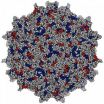(Press-News.org) Ann Arbor, Mich. – New American Diabetes Association (ADA) screening guidelines may lead to the missed diagnoses of type 2 diabetes in children, according to a new study by University of Michigan.
The research, published in the Journal of Adolescent Health, finds that both pediatric and family medicine providers who care for children are using screening tests for type 2 diabetes that may result in missed diagnoses for children, says lead author Joyce Lee, M.D., M.P.H., associate professor in U-M's Departments of Pediatrics and Communicable Diseases and Environmental Health Sciences.
In 2010, the ADA recommended that physicians use Hemoglobin A1c screening tests, rather than glucose tests for identifying children and adults with pre-diabetes and diabetes. However, this change has been controversial, because of lower test performance of HbA1c in children compared with adults.
The study found that when presented with the ADA screening guidelines, 84% of physicians reported that they would switch from using glucose tests to using HbA1c tests.
"This potential for increased uptake of HbA1c could lead to missed cases prediabetes and diabetes in children, and increased costs," says Lee.
"A number of studies have shown that HbA1c has lower test performance in pediatric compared with adult populations, and as a result, increased uptake of HbA1c alone or in combination with non-fasting tests could lead to missed diagnoses of type 2 diabetes in the pediatric population.
'"Also, a recent analysis of screening strategies found that HbA1c is much less cost-effective than other screening tests, which would result in higher overall costs for screening."
The study was based on a national sample of providers from pediatrics and family practice.
"Greater awareness of the 2010 ADA guidelines will likely lead to increased uptake of HbA1c and a shift to use of non-fasting tests to screen for adolescents with type 2 diabetes. This may have implications for detection rates for diabetes and overall costs of screening."
INFORMATION:
Additional authors: All from the University of Michigan: Ashley Eason, M.P.H.; Courtney Nelson; Nayla G. Kazzi; Anne E. Cowan, M.P.H.; and Beth A. Tarini, M.D., M.S.
About the U-M Comprehensive Diabetes Center: The mission of the University of Michigan Comprehensive Diabetes Center (MCDC) is to pioneer the way diabetes research is conducted and applied by generating new knowledge, forging new relationships, and enabling collaborations -- both internally, among U-M researchers and clinicians, and externally, with diabetes experts from around the world. MCDC has been consistently ranked in the top 20 nationally for diabetes care. http://www.med.umich.edu/diabetes/
Dr. Lee was supported by NIDDK K08 DK082386 and the Clinical Sciences Scholars Program at the University of Michigan. She can be found on Twitter at @joyclee
Change in guidelines for Type 2 diabetes screening may lead to under-diagnosis in children
New guidelines for Type 2 diabetes screening in children are less effective and more costly than previous screening methods
2014-02-12
ELSE PRESS RELEASES FROM THIS DATE:
New imaging technique can diagnose common heart condition
2014-02-12
CHICAGO --- A new imaging technique for measuring blood flow in the heart and vessels can diagnose a common congenital heart abnormality, bicuspid aortic valve, and may lead to better prediction of complications.
A Northwestern Medicine team reported the finding in the journal Circulation. In the study, the authors demonstrated for the first time a previously unknown relationship between heart valve abnormalities, blood flow changes in the heart and aortic disease. They showed that blood flow changes were driven by specific types of abnormal aortic valves, and they were ...
Four new galaxy clusters take researchers further back in time
2014-02-12
Four unknown galaxy clusters each potentially containing thousands of individual galaxies have been discovered some 10 billion light years from Earth.
An international team of astronomers, led by Imperial College London, used a new way of combining data from the two European Space Agency satellites, Planck and Herschel, to identify more distant galaxy clusters than has previously been possible. The researchers believe up to 2000 further clusters could be identified using this technique, helping to build a more detailed timeline of how clusters are formed.
Galaxy clusters ...
Thatcher's policies condemned for causing 'unjust premature death'
2014-02-12
Dr Alex Scott-Samuel and colleagues from the Universities of Durham, West of Scotland, Glasgow and Edinburgh, sourced data from over 70 existing research papers, which concludes that as a result of unnecessary unemployment, welfare cuts and damaging housing policies, the former prime minister's legacy "includes the unnecessary and unjust premature death of many British citizens, together with a substantial and continuing burden of suffering and loss of well-being."
Speaking about the figures, Dr Scott-Samuel said: "Towards the end of the 1980s we were seeing around 500 ...
Better RNA interference, inspired by nature
2014-02-11
CAMBRIDGE, MA -- Inspired by tiny particles that carry cholesterol through the body, MIT chemical engineers have designed nanoparticles that can deliver snippets of genetic material that turn off disease-causing genes.
This approach, known as RNA interference (RNAi), holds great promise for treating cancer and other diseases. However, delivering enough RNA to treat the diseased tissue, while avoiding side effects in the rest of the body, has proven difficult.
The new MIT particles, which encase short strands of RNA within a sphere of fatty molecules and proteins, silence ...
University of Tennessee study finds crocodiles climb trees
2014-02-11
When most people envision crocodiles, they think of them waddling on the ground or wading in water—not climbing trees. However, a University of Tennessee, Knoxville, study has found that the reptiles can climb trees as far as the crowns.
Vladimir Dinets, a research assistant professor in the Department of Psychology, is the first to thoroughly study the tree-climbing and -basking behavior. The research is published in the journal Herpetology Notes and can be found at http://bit.ly/Myi8yr.
Dinets and his colleagues observed crocodile species on three continents—Australia, ...
Caltech-developed method for delivering HIV-fighting antibodies proven even more promising
2014-02-11
In 2011, biologists at the California Institute of Technology (Caltech) demonstrated a highly effective method for delivering HIV-fighting antibodies to mice—a treatment that protected the mice from infection by a laboratory strain of HIV delivered intravenously. Now the researchers, led by Nobel Laureate David Baltimore, have shown that the same procedure is just as effective against a strain of HIV found in the real world, even when transmitted across mucosal surfaces.
The findings, which appear in the February 9 advance online publication of the journal Nature Medicine, ...
The content of our cooperation, not the color of our skin
2014-02-11
It's widely acknowledged that a common threat unites people. Individuals who were previously separated by social class, race or ethnicity come together, forming new cooperative alliances to defeat a common enemy. But does it take an external threat — an attack like Pearl Harbor or 9/11 — to make these social divisions melt away?
A study by behavioral scientists at UC Santa Barbara demonstrates that peaceful cooperation has the same effect as intergroup conflict in erasing social boundaries connected to race. Their findings appear today in the journal PLOS ONE.
"Evolution ...
Fish living near the equator will not thrive in the warmer oceans of the future
2014-02-11
According to an international team of researchers, the rapid pace of climate change is threatening the future presence of fish near the equator.
"Our studies found that one species of fish could not even survive in water just three degrees Celsius warmer than what it lives in now," says the lead author of the study, Dr Jodie Rummer from the ARC Centre of Excellence for Coral Reef Studies (Coral CoE) at James Cook University.
Dr Rummer and her colleagues studied six common species of fish living on coral reefs near the equator. She says many species in this region only ...
How our brain networks: Research reveals white matter 'scaffold' of human brain
2014-02-11
For the first time, neuroscientists have systematically identified the white matter "scaffold" of the human brain, the critical communications network that supports brain function.
Their work, published Feb. 11 in the open-source journal Frontiers in Human Neuroscience, has major implications for understanding brain injury and disease. By detailing the connections that have the greatest influence over all other connections, the researchers offer not only a landmark first map of core white matter pathways, but also show which connections may be most vulnerable to damage.
"We ...
Scientists identify gene linking brain structure to intelligence
2014-02-11
For the first time, scientists at King's College London have identified a gene linking the thickness of the grey matter in the brain to intelligence. The study is published today in Molecular Psychiatry and may help scientists understand biological mechanisms behind some forms of intellectual impairment.
The researchers looked at the cerebral cortex, the outermost layer of the human brain. It is known as 'grey matter' and plays a key role in memory, attention, perceptual awareness, thought, language and consciousness. Previous studies have shown that the thickness of ...
LAST 30 PRESS RELEASES:
Study: Teens use cellphones for an hour a day at school
After more than two years of war, Palestinian children are hungry, denied education and “like the living dead”
The untold story of life with Prader-Willi syndrome - according to the siblings who live it
How the parasite that ‘gave up sex’ found more hosts – and why its victory won’t last
When is it time to jump? The boiling frog problem of AI use in physics education
Twitter data reveals partisan divide in understanding why pollen season's getting worse
AI is quick but risky for updating old software
Revolutionizing biosecurity: new multi-omics framework to transform invasive species management
From ancient herb to modern medicine: new review unveils the multi-targeted healing potential of Borago officinalis
Building a global scientific community: Biological Diversity Journal announces dual recruitment of Editorial Board and Youth Editorial Board members
Microbes that break down antibiotics help protect ecosystems under drug pollution
Smart biochar that remembers pollutants offers a new way to clean water and recycle biomass
Rice genes matter more than domestication in shaping plant microbiomes
Ticking time bomb: Some farmers report as many as 70 tick encounters over a 6-month period
Turning garden and crop waste into plastics
Scientists discover ‘platypus galaxies’ in the early universe
Seeing thyroid cancer in a new light: when AI meets label-free imaging in the operating room
Neutrophil-to-lymphocyte ratio may aid risk stratification in depressive disorder
2026 Seismological Society of America Annual Meeting
AI-powered ECG analysis offers promising path for early detection of chronic obstructive pulmonary disease, says Mount Sinai researchers
GIMM uncovers flaws in lab-grown heart cells and paves the way for improved treatments
Cracking the evolutionary code of sleep
Medications could help the aging brain cope with surgery, memory impairment
Back pain linked to worse sleep years later in men over 65, according to study
CDC urges ‘shared decision-making’ on some childhood vaccines; many unclear about what that means
New research finds that an ‘equal treatment’ approach to economic opportunity advertising can backfire
Researchers create shape-shifting, self-navigating microparticles
Science army mobilizes to map US soil microbiome
Researchers develop new tools to turn grain crops into biosensors
Do supervised consumption sites bring increased crime? Study suggests that’s a myth
[Press-News.org] Change in guidelines for Type 2 diabetes screening may lead to under-diagnosis in childrenNew guidelines for Type 2 diabetes screening in children are less effective and more costly than previous screening methods



